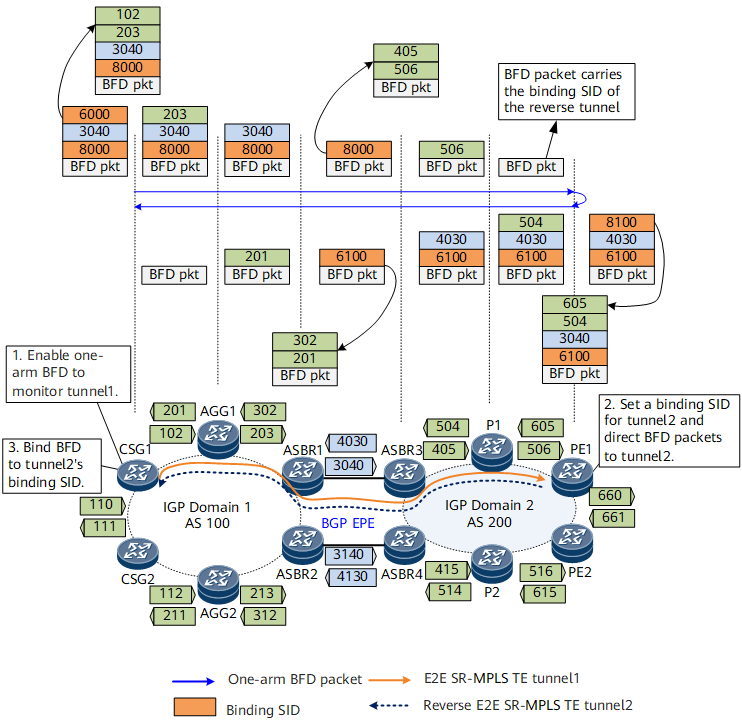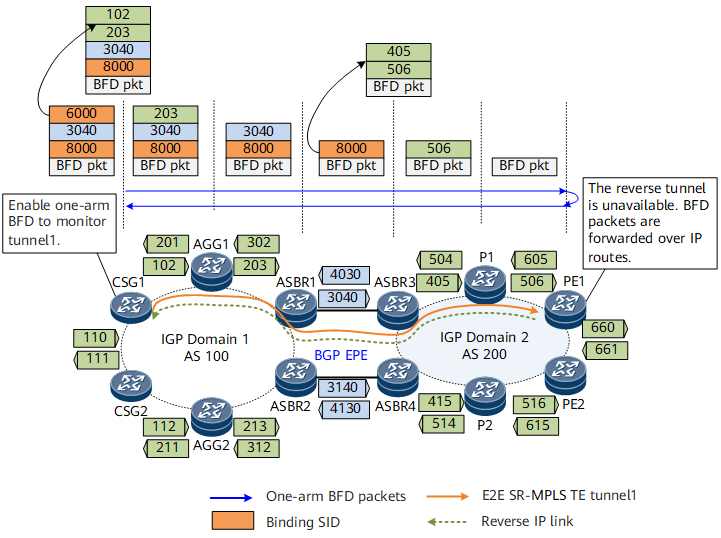One-Arm BFD for E2E SR-MPLS TE
- One-arm BFD for E2E SR-MPLS TE LSP: When an E2E SR-MPLS TE LSP is established and a BFD session fails to be negotiated, the SR-MPLS TE LSP cannot go Up. BFD for E2E SR-MPLS TE LSP rapidly triggers a primary/HSB LSP switchover if the primary LSP fails.
BFD for E2E SR-MPLS TE tunnel: The E2E SR-MPLS TE tunnel status is monitored using both BFD for E2E SR-MPLS TE tunnel and BFD for E2E SR-MPLS TE LSP.
BFD for E2E SR-MPLS TE LSP controls the primary/HSB LSP switchover and switchback status, whereas BFD for E2E SR-MPLS TE tunnel controls the effective status of a tunnel. If BFD for E2E SR-MPLS TE tunnel is not configured, the default tunnel status keeps Up, and the effective status cannot be determined.
The interface status of an E2E SR-MPLS TE tunnel keeps consistent with the status of BFD for E2E SR-MPLS TE tunnel. The BFD session goes Up slowly because of BFD negotiation. In general, if a new label stack is delivered for a tunnel in the down state, it takes approximately 10 to 20 seconds for BFD to go up. This consequently slows down hard convergence when other protection functions are not configured for the tunnel.
- Enable BFD and specify the one-arm mode to establish a BFD session on the ingress.
- Establish a reverse E2E SR-MPLS TE tunnel in advance on the egress and set a binding SID for the tunnel.
- Bind the BFD session to the binding SID of the reverse E2E SR-MPLS TE tunnel on the ingress.
After the one-arm BFD session is established, the ingress sends a one-arm BFD packet that carries the binding SID of the reverse tunnel. After the one-arm BFD packet arrives at the egress through a transit node along the SR-MPLS TE tunnel, the forwarding plane removes the MPLS label from the BFD packet and associates it with the reverse SR-MPLS TE tunnel based on the binding SID carried in the one-arm BFD packet. The reverse BFD packet is attached with a label stack of the E2E SR-MPLS TE tunnel and looped back to the ingress through the transit node along the SR-MPLS TE tunnel. The ingress processes the detection packet to implement the one-arm loopback detection mechanism.
If the egress does not have a reverse E2E SR-MPLS TE tunnel, the egress searches for an IP route based on the destination address of the BFD packet to loop back the packet, as shown in Figure 2.

